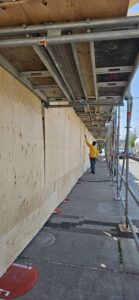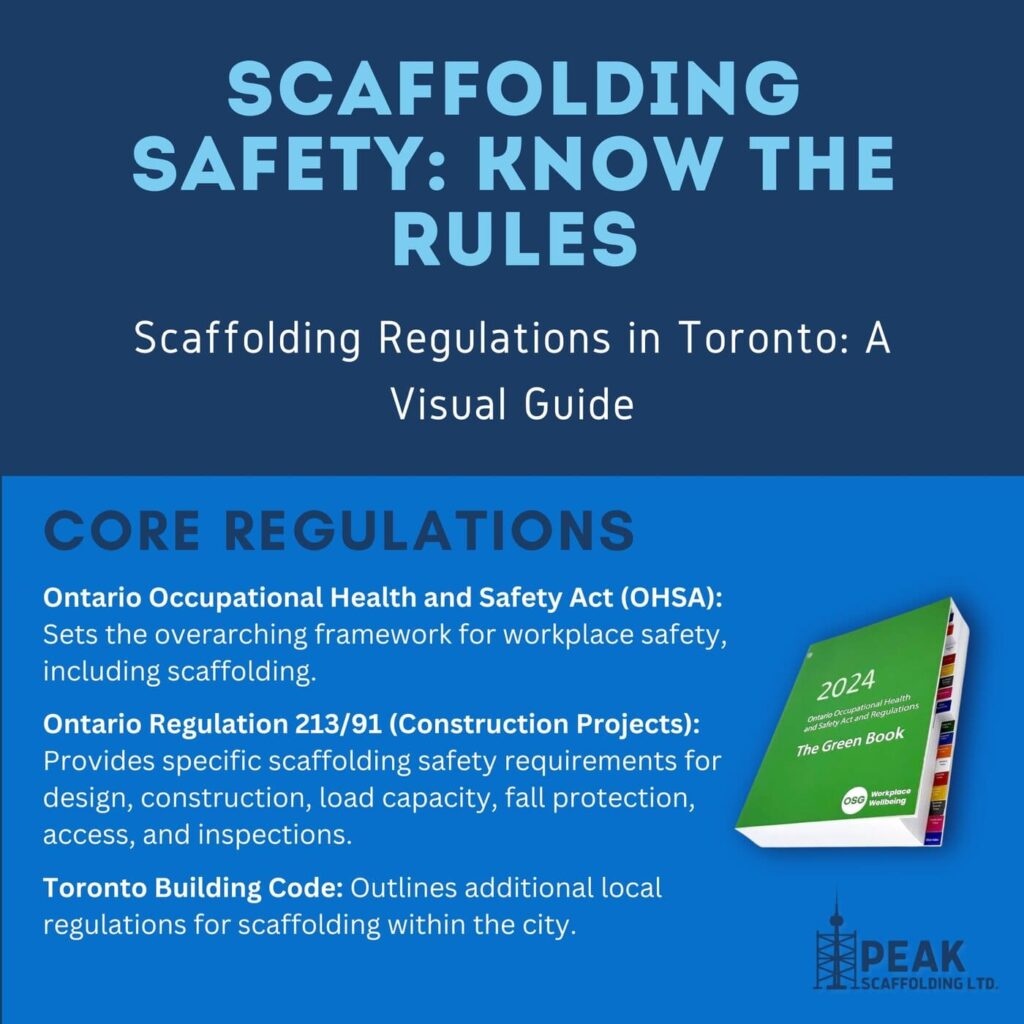Introduction
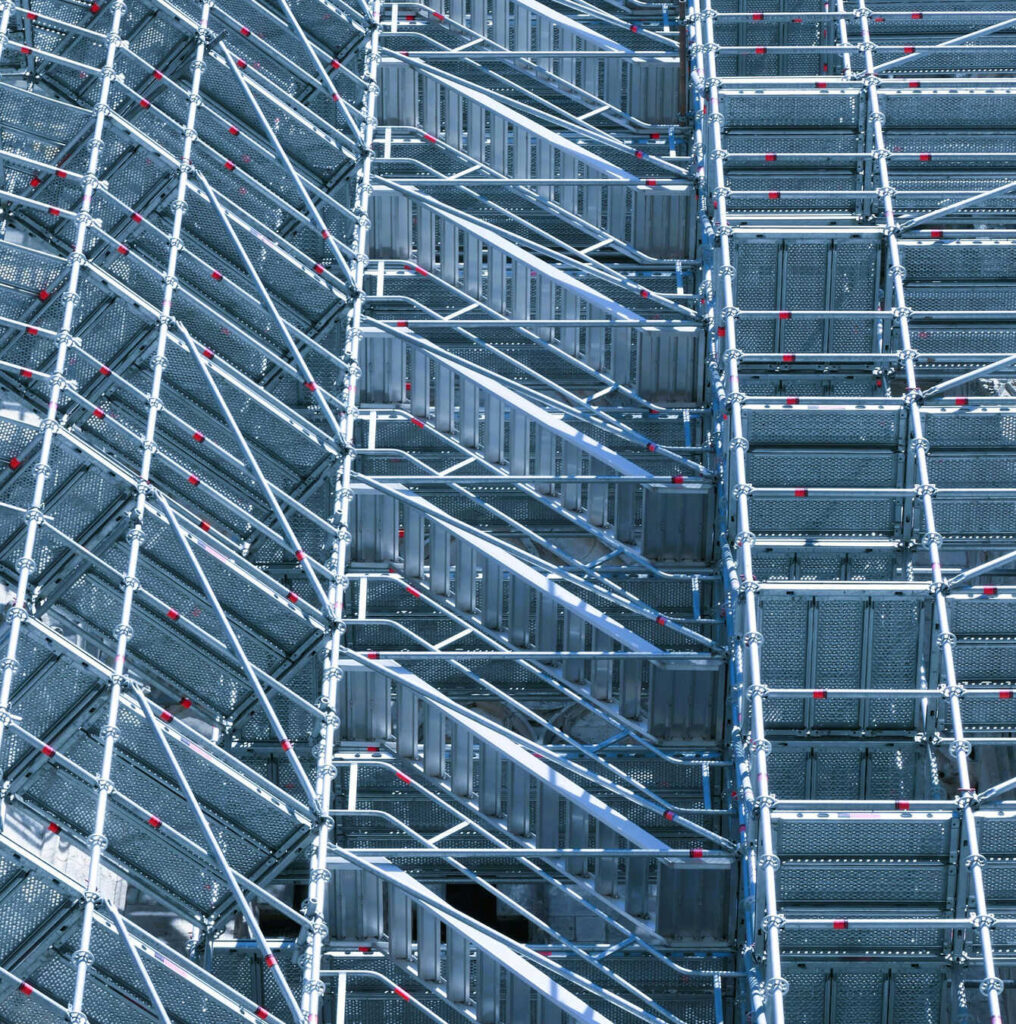
Scaffolding is the unsung hero of most construction projects, providing essential access and support for workers at heights. But not all scaffolding systems are created equal. Choosing the right one can mean the difference between a smooth, efficient project and one plagued by delays, safety risks, and budget overruns.
This comprehensive guide will walk you through everything you need to know to choose the ideal scaffolding system for your specific needs. We’ll cover the different types of scaffolding, key factors to consider, and how PEAK Scaffolding’s expertise can help you make the best decision for your Toronto project.
Why Choosing the Right System Matters
Selecting the correct scaffolding system is a critical decision that impacts:
- Safety: The right scaffolding ensures worker safety by providing a stable and secure platform. The wrong choice can lead to accidents and injuries.
- Efficiency: A well-suited system streamlines work processes, allowing workers to access all areas of the project easily and quickly.
- Cost-Effectiveness: Choosing the appropriate scaffolding can optimize material usage, minimize labour costs, and reduce project timelines.
Investing time and effort in selecting the right scaffolding system upfront will pay dividends throughout your project.
Understanding Your Project Needs: The First Step in Choosing the Right Scaffolding
Before diving into the world of scaffolding systems, it’s crucial to assess your project’s unique requirements. This step is like laying the foundation for a building – it sets the stage for making informed decisions that will ensure the safety, efficiency, and success of your construction endeavours.
Key Questions to Ask
To determine the right scaffolding system for your project, consider the following questions:
- What is the scope of your project? Are you constructing a new building, renovating an existing structure, or performing maintenance tasks? Different projects have varying access needs, which will influence the type of scaffolding required.
- What are the site conditions like? Consider the terrain (flat, uneven, sloped), accessibility for equipment and materials, and any potential obstacles like overhead power lines or nearby structures.
- What is the building’s height and shape? Tall structures or those with complex designs may necessitate specialized scaffolding solutions.
- What is the estimated weight capacity needed? Account for the weight of workers, tools, materials, and any equipment that will be on the scaffold.
- How long will the scaffolding be in use? Short-term projects may benefit from quick-to-assemble systems, while long-term projects may prioritize durability.
- What is your budget? Scaffolding costs can vary significantly depending on the type and complexity of the system. Determine your budget early on to narrow down your options.
Why a Needs Assessment is Crucial
A thorough needs assessment is the cornerstone of choosing the right scaffolding system. By understanding your project’s unique requirements, you can:
- Prioritize Safety: Select a system that can safely accommodate the intended loads and heights.
- Optimize Efficiency: Choose a system that allows for easy access and movement for workers.
- Control Costs: Select a cost-effective solution that meets your budget without sacrificing safety or functionality.
- Ensure Compliance: Identify any specific regulations that may apply to your project, such as those related to heritage buildings or environmentally sensitive areas.
At PEAK Scaffolding, we understand that each project is unique. Our experienced team will conduct a comprehensive assessment of your project’s needs, taking into account all relevant factors. We’ll work closely with you to develop a tailored scaffolding solution that maximizes safety, efficiency, and cost-effectiveness.
Don’t leave your scaffolding choices to chance. A well-informed decision based on your project’s needs will pave the way for a smoother, safer, and more successful construction process.
Types of Scaffolding Systems: Exploring Your Options
Now that you have a clear understanding of your project needs, let’s delve into the various scaffolding systems available. Each type offers distinct advantages and caters to specific applications.
Supported Scaffolding: A Reliable Foundation
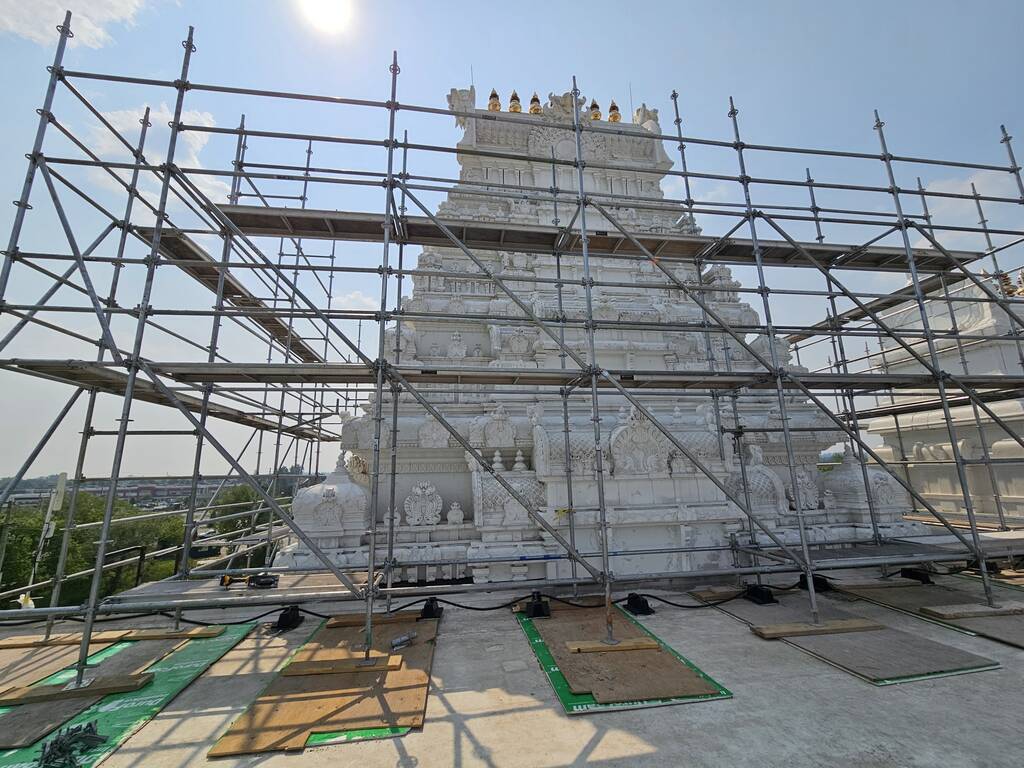
Supported scaffolding is the most common type, offering a sturdy and versatile solution for various construction projects. It consists of vertical supports (standards) that rest on a solid base, connected by horizontal members (ledgers) and diagonal braces for stability.
- Pros: Strong, stable, adaptable to various configurations, ideal for most construction projects.
- Cons: Can be time-consuming to erect and dismantle, may not be suitable for complex structures or restricted spaces.
PEAK Scaffolding's Expertise: Ringlock System

At PEAK Scaffolding, we specialize in the Ringlock System, a cutting-edge supported scaffolding solution. This innovative system utilizes interlocking components to create a robust and flexible framework. Its modular design allows for quick and easy assembly, saving you valuable time and resources.
The Ringlock System boasts impressive load-bearing capacity, making it suitable for even the most demanding projects. It’s also incredibly versatile, adaptable to various configurations like cantilevers, debris chutes, stair towers, and more.
Suspended Scaffolding: Reaching New Heights
Suspended scaffolding hangs from a rooftop or other overhead structure. This makes it an excellent choice for work on tall buildings or where ground-level support is impractical.
- Pros: Ideal for high-rise work, adaptable to various building shapes, offers unobstructed access to facades.
- Cons: Requires specialized installation and safety procedures, may be less stable than supported scaffolding in windy conditions.
Rolling Scaffolding: Mobility on Demand
Rolling scaffolding, as the name suggests, is equipped with wheels, providing mobility and flexibility on the job site. It’s commonly used for interior tasks like painting, drywalling, and electrical work.
- Pros: Easy to move and reposition, ideal for interior work, provides a stable platform for work at lower heights.
- Cons: Limited height reach, not suitable for heavy loads or uneven terrain.
Tube and Clamp Scaffolding: The Versatile Classic
Tube and clamp scaffolding is a time-tested system renowned for its flexibility and adaptability. It consists of steel tubes connected by clamps, allowing for virtually endless configurations.
- Pros: Highly customizable, suitable for complex structures and hard-to-reach areas, durable and capable of handling heavy loads.
- Cons: Can be more time-consuming to assemble than modular systems, requires skilled labor for proper installation.
PEAK Scaffolding's Expertise: Tube and Clamp
At PEAK Scaffolding, we’re well-versed in the intricacies of tube and clamp scaffolding. Our experienced team can design and install custom solutions tailored to your project’s specific needs, ensuring safety and efficiency.
Specialty Scaffolding: For Unique Challenges
In addition to the common types mentioned above, there are various specialty scaffolding systems designed to address specific challenges. These include:
- Cantilever Scaffolding: Extends outwards from a building, supported by a series of brackets.
- Trestle Scaffolding: A self-supporting structure used for low-level access.
- Mast Climber Scaffolding: A motorized platform that travels vertically along a mast.
These specialized systems cater to niche applications and may require additional expertise for safe and effective use.
With a plethora of scaffolding systems available, it’s essential to choose the right one for your project. By understanding the different types and their applications, you’re one step closer to making an informed decision that will benefit your project’s safety, efficiency, and success.
Key Factors to Consider When Choosing a Scaffolding System
Now that we’ve explored the different types of scaffolding, let’s dive into the key factors that will help you make the right choice for your project:
Safety Regulations: The Non-Negotiable
Safety should always be the top priority in any construction project. In Toronto, scaffolding is subject to strict regulations outlined in the Ontario Occupational Health and Safety Act (OHSA), Ontario Regulation 213/91, and the Toronto Building Code.
It’s crucial to choose a scaffolding system that complies with all relevant regulations, ensuring the safety of your workers and the public. Working with a reputable scaffolding provider like PEAK Scaffolding can give you peace of mind, knowing that your scaffolding system meets or exceeds all safety requirements.
Ease of Assembly and Dismantling: Time is Money
The time it takes to erect and dismantle scaffolding can significantly impact your project’s timeline and labor costs. Opt for a system that is easy and efficient to assemble, especially if you have a tight schedule or limited manpower. Modular systems like the Ringlock System are known for their quick assembly, saving you valuable time and resources.
Flexibility and Adaptability: Handling the Unexpected
Construction projects rarely go exactly as planned. Unexpected challenges and changes can arise, requiring adjustments to your scaffolding system. Choose a system that is flexible and adaptable to different configurations, such as the Tube and Clamp system. This will allow you to easily modify the scaffolding to accommodate unforeseen obstacles or changes in project scope.
Durability and Stability: Building a Strong Foundation
Scaffolding must be able to withstand the weight of workers, materials, and equipment while remaining stable under various conditions. Consider the following:
- Load Capacity: Ensure the system is rated for the maximum intended load, with a safety factor to account for unforeseen circumstances.
- Weather Resistance: Choose materials that can withstand Toronto’s weather conditions, such as high winds, rain, and snow.
- Structural Integrity: Opt for a system with a proven track record of durability and stability.
Cost: Balancing Your Budget
Scaffolding costs can vary significantly depending on the type of system, project duration, and rental or purchase options. While it’s important to be mindful of your budget, don’t sacrifice safety or functionality for the sake of cost savings.
Consider the long-term value of your investment. A high-quality, durable scaffolding system may have a higher upfront cost but can save you money in the long run through increased efficiency, reduced downtime, and fewer maintenance requirements.
At PEAK Scaffolding, we understand the importance of balancing cost with quality and safety. We offer competitive pricing on our scaffolding rentals and services, ensuring you get the best value for your investment. Our team can also help you explore different financing options to make your project more affordable.
FAQs About Choosing a Scaffolding System
Both Ringlock and Tube & Clamp systems offer high versatility. Ringlock excels at adaptability, with its modular design allowing for easy reconfiguration. Tube & Clamp, however, provides ultimate customization for complex shapes and angles. The “most versatile” really depends on your project’s specific needs.
All scaffolding systems, when properly installed and maintained, can be safe. However, Ringlock is often considered safer due to its interlocking design, which reduces the risk of components coming loose. Ultimately, the safest system is the one that is best suited to your project’s specific requirements and used correctly.
The decision to rent or buy depends on the frequency of use and project duration. For short-term or occasional use, renting is often more cost-effective. However, if you anticipate frequent use or have long-term projects, buying can be a better investment in the long run.
Working with a reputable scaffolding provider like PEAK Scaffolding ensures compliance. We stay up-to-date on all regulations and ensure your system meets or exceeds safety standards.
Costs vary depending on the type of system, project size, and rental or purchase options. PEAK Scaffolding offers competitive pricing and can help you explore the most cost-effective solution for your project.
Look for a provider with:
- Experience in your type of project.
- A strong commitment to safety and compliance.
- Expertise in different scaffolding systems.
- A reputation for quality work and customer satisfaction.
Conclusion: Your Partner in Scaffolding Success
Choosing the right scaffolding system is a critical decision that impacts the safety, efficiency, and overall success of your construction project. By understanding your project needs, exploring the different types of scaffolding, and considering key factors like safety, ease of use, flexibility, and cost, you can make an informed choice that will benefit your project in the long run.
PEAK Scaffolding is your trusted partner in navigating the complexities of scaffolding selection and implementation. We offer expert guidance, tailored solutions, and a steadfast commitment to safety and quality.
Ready to choose the right scaffolding system for your project? Contact PEAK Scaffolding today for a free consultation and let us help you elevate your construction endeavors.
Related Posts
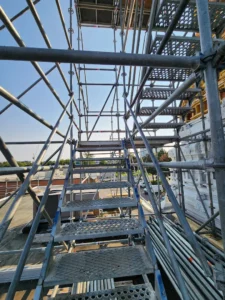

Toronto Building Codes and Scaffolding: What You Must Comply With

